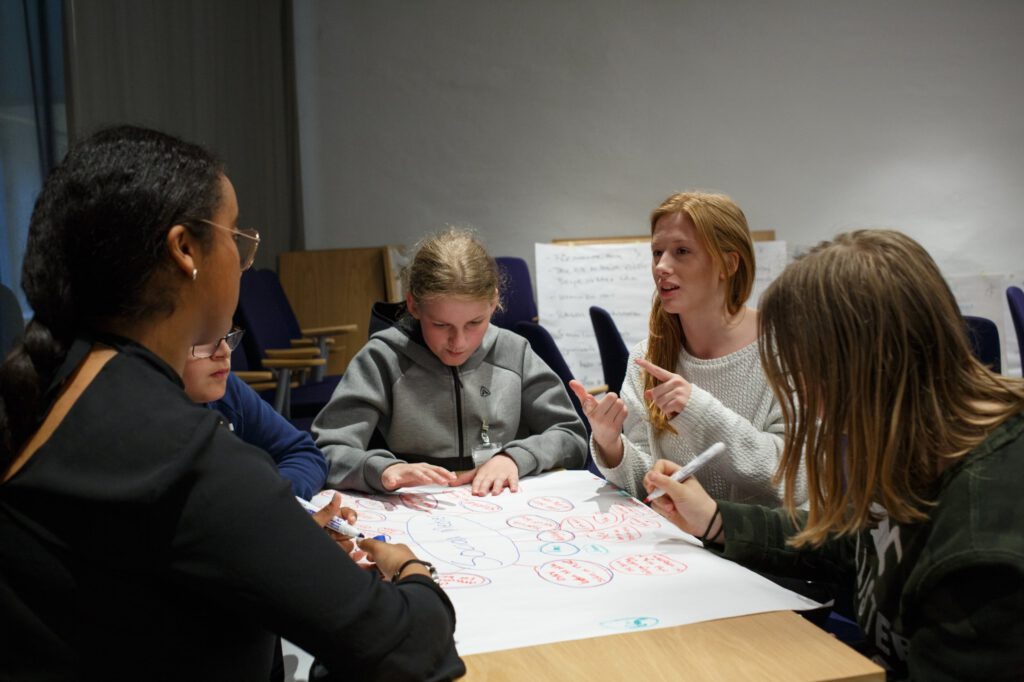All Teachers Are Language Teachers: Celebrating Linguistic Diversity in the Classroom
In today’s diverse and interconnected world, classrooms are filled with students from various linguistic and cultural backgrounds. Regardless of the subject area of grade level, educators must equip themselves with the knowledge and skills necessary to support students with diverse linguistic needs. In this blog post, we will delve into the importance of embracing linguistic diversity and discuss how teachers can enhance their abilities to create inclusive learning environments. Ultimately, all teachers are language teachers with the responsibility to support multilingual learners.
In May of 2023, educational leaders from Moreland University engaged in a comprehensive discussion on teaching multilingual learners. I was joined by our Chief Academic Officer Dr. Kerri Valencia and Director of Research and Data Analytics Dr. Daphne Moriel de Cedeño, along with two esteemed faculty members, Barry Fargo, M.Ed. and Dr. Adam Morgan in our webinar, “Artificial Intelligence and Inclusive Education: Teaching Multilingual Learners in 2023-24 and Beyond.” Together we explored powerful ways educational technology and artificial intelligence (AI) can help teachers personalize learning and innovate lessons to equitably promote language acquisition. By highlighting best practices, inclusive strategies, and tools to support multilingual students in the evolving landscape of educational technology, the webinar provides valuable insights for educators seeking to create inclusive and responsive learning environments.
Let’s explore the ideas and perspectives shared by the panelists in this webinar. To encourage creating inclusive learning environments, panelists offer valuable insights on the role of teachers as facilitators of language acquisition and advocates for multilingual learners. Each panelist brings unique expertise to the discussion on why all teachers are language teachers.
Dr. Daphne Moriel De Cedeño stresses the importance of language acquisition skills for all students, stating, “All teachers are teachers of multilingual learners because all students are lifelong language learners.” Teachers must develop students’ language skills in every classroom, regardless of whether students are learning their first or fifth language. Strategies to develop students’ language include explicitly teaching vocabulary, providing sentence frames to support communication, integrating culturally relevant learning materials, and creating a safe classroom climate for language learning. When teachers support language learning in instruction, they promote culturally rich learning with, “…both windows and mirrors into the lives of diverse people.”
Educators can create an environment that fosters the cognitive, social, emotional, and linguistic growth of their students by reflecting on their own language use in the classroom. Barry Fargo, M.Ed. highlights the capacity and responsibility that teachers possess in supporting the holistic development of multilingual learners by developing their own metalinguistic awareness: “A great place for teachers to start to become prepared to teach multilingual learners is to grow their own metalinguistic awareness by reflecting on their language use in the classroom.” Understanding that all teachers are language teachers, according to Barry, is fundamental to cultivating an equitable, inclusive, and supportive learning atmosphere.
Dr. Kerri Valencia speaks to the role of technology in the linguistically diverse classroom. She recommends, “In terms of technology, it’s critical to use technology as a tool and not a crutch. Just as we need to teach through an additive lens towards our students, we need to have the same approach to technology.” She also underscores the significance of ongoing professional development, reflection, and adaptation of curriculum to meet the needs of linguistically diverse learners. One way that teachers can support multilingual learners is by honoring students’ first languages and incorporating them into the learning process. Allowing students to engage in multilingual communication through inclusive instructional strategies including translanguaging helps foster engaging environments that celebrate student identities. Language learning is universal, and teachers should value the linguistic diversity within their classrooms.
Finally, Dr. Adam Morgan emphasizes the importance of student-centered learning in supporting multilingual learners. Highlighting the impact of a student-centered approach, he shares, “Professional development and experience are essential to supporting multilingual learners, but having a laser-like focus on the student will enable you to meet their needs regardless of language and cultural barriers.” By focusing on the individual needs and strengths of each student, educators can effectively address language and cultural differences and ensure every student receives the support successful language acquisition.
These perspectives shed light on the integral role teachers of all subject areas and grade levels play in fostering language acquisition and supporting multilingual learners. By embracing students’ diverse linguistic and cultural backgrounds, reflecting on their instructional practices, and continuously seeking professional growth, educators promote inclusion and empower all students to thrive. In this way, educators can appreciate diversity within their classrooms and celebrate the rich tapestry of linguistic backgrounds.
M.Ed. Teaching Multilingual Learners
At Moreland University, we understand the importance of equipping teachers with the necessary skills to teach multilingual learners effectively. Our Master’s Degree in Education (M.Ed.) with a focus on Teaching Multilingual Learners is designed to prepare educators to meet the unique needs of culturally and linguistically diverse student populations. Through this program, educators delve into fundamental concepts of language, language development, and culturally-linguistically diverse populations. They learn pedagogical principles and approaches to integrate language instruction through a socio-cultural lens across various domains of linguistic development.
Educators acquire practical strategies to apply theories and methods for grammar and vocabulary in diverse educational contexts. The curriculum places particular emphasis on assessing and providing feedback to learners, as well as developing strategies for building a language-supported classroom. With our M.Ed. program, educators can enhance their expertise and empower themselves to create inclusive learning environments that foster the linguistic development of multilingual learners.
Embracing linguistic diversity is essential for teachers in the modern educational landscape. All educators should be equipped, enabled, and empowered to teach students with diverse linguistic and cultural backgrounds. As teachers, we play a crucial role in celebrating and supporting the rich diversity present in our classrooms. Through programs like Moreland University’s M.Ed. Teaching Multilingual Learners, educators can expand their knowledge and skills, making a positive impact on the educational journey of their students.
Remember, all teachers are language teachers who can create responsive and inclusive learning environments where multilingual students can thrive!



